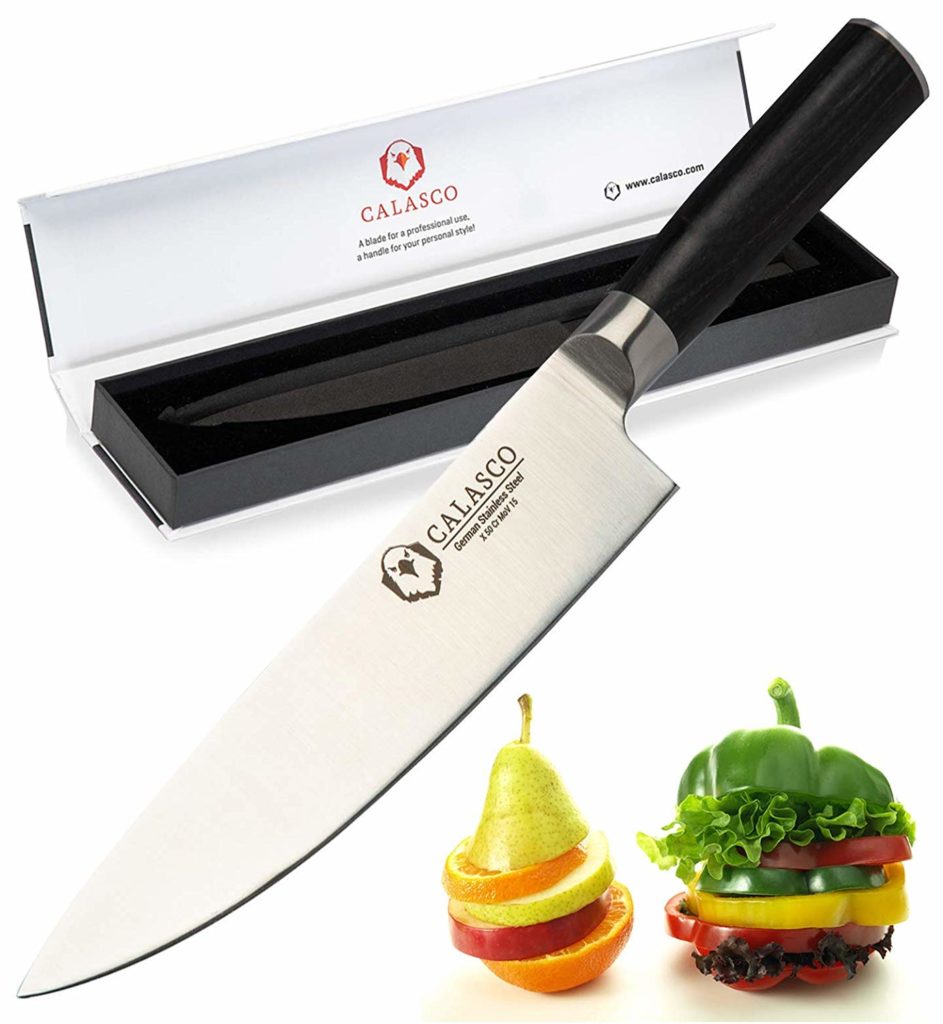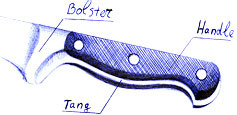
Kitchen knives come in all shapes and sizes, each with a different function. To work efficiently in your kitchen you must know which knife to use for what purpose. As a beginning, you need only get the first three knives listed below. As time goes on, and your needs grow and become more refined, you can add others to your collection.
1. Chef’s knife (or Cook’s Knife): this is the knife you’ll probably use most often, because it is multifunctional. Its blade, is stiff and wide, and from 6 to 12 inches (15 to 30 cm) long with a sharp tip. You can use it to…
- slice
- chop
- dice, mince
- grind spices, for example, with the flat of the blade…

2. Paring knife: a small knife, ideal for more delicate work. You can, for example, use it to work on items of food while holding them in your other hand, by…
- peeling potatoes or removing their blemishes
- chopping garlic or parsley
- coring peaches or apples
- decorating products for garnish in some more interesting way…

The blade of a paring knife is thin, narrow, and sharp at the tip. It is from 2 to 4,5 inches (5 to 11 cm) in length, and the cutting edge may be either straight, or serrated, or a mixture of the two. (The blade may also resemble a bird’s beak. This is a subspecies of the paring knife, also known as a peeling knife.)
3. Bread knife: this knife enables you to cut hard, thick bread crusts quite effortlessly. You can also use it to cut very fresh bread, cake, water-melon, etc. Its blade is usually serrated and from 5 to 9 inches (13 to 23 cm) long; enough to cut slices from long or round loaves of bread.

Other kitchen knives for different purposes
4. Utility knife: a knife that is something between a chef’s knife and paring knife. It is especially useful for soft foods, such as…
- the skin of raw sausage or tomatoes
- other vegetables and fruits
- other small items of food with a hard crust…

Its blade is firm, narrow and from 5 to 8 inches (13 to 20 cm) long. In addition to being smooth, the cutting edge may be serrated as well.
5. Boning knife: a good choice if you frequently work with raw meat products. You can use it for boning fish, chicken or beef, cutting through the joints of meat, removing tendons, fat, fish skin, etc. Its blade is from 4 to 7 inches (10 to 18 cm) long. It is flexible (although it may be firm as well), narrow, curved and with a sharp tip. (Some knives of this kind have a longer blade, from 6 to 11 inches (15 to 28 cm) long. These are also known as fillet knives.)

6. Carving knife: to cut meat, poultry or fish that has already been prepared. Its blade is from 8 to 15 inches (20 to 38 cm) long; enough to cut good serving pieces in one motion. It may be firm, for cutting rougher kinds of meat…
- roast beef ribs
- pork
- joints…

Or flexible (these knives are also known as slicers) for finer meats…
- ham
- roast chicken, turkey
- smoked or dried fish…
Some of these kitchen knives are equipped with a fork, to hold the meat while cutting. This both holds the meat firmly while cutting and ensures that you do not cut yourself.
7. Cleaver: a knife with a wide, heavy, firm blade. You can use it to…
- cut and chop big bones
- chop poultry, meat or fish
- crush or grind seeds, garlic, etc., with the flat of the blade…

For generally harder tasks.
8. Steak knives: for use when eating, to cut prepared meat (or other types of food) into mouth-sized pieces. Their blade is narrow, thin and from 4 to 6 inches (10 to 15 cm) long. The cutting edge may be smooth, serrated, or both.

9. Asian knives: these kitchen knives will be probably more comfortable for you if you cook Asian foods frequently. They are lighter, thinner and sharper. More popular types are Santoku, Deba Knife, Usuba, Fish Knives…

Santoku combines a chef’s knife and, to some extent, a cleaver. This makes it useful for different purposes.
10. Special kitchen knives:
- for cheese
- for fruits
- for tomatoes
- for seafood…
You will find that some of the knives listed above have hollows on the blade. Thus the produce won’t stick to the blade when you want to cut it into very thin slices.
What are kitchen knives made from
1. Metal part.
The metal part of the knives may be…
- high carbon stainless steel
- high carbon steel
- stainless steel, ceramic, titan, molybdenum-vanadium…
It may be…
- forged
- stamped
- welded together from different pieces…
Some of the highest-quality kitchen knives are made from forged, high carbon stainless steel. These knives are durable, strong and remain sharp for a long time. They won’t stain, rust or add a metallic taste to your food.
The metal for the blade of these knives continues along the whole length of the knife, so that everything is one complete unit. This gives stability and strength to the knife. Between the blade and the tang (the metal piece to which the handle is attached) there is usually a bolster (a thick piece of metal that aids the balance and the weight of the knife.)

Stamped knives don’t have a bolster because they are made from steel sheet. They are light, and also uncomfortable to use because of the lack of good balance. Further, they become blunt fairly quickly. Hence, their price is correspondingly lower than the forged, high carbon stainless steel knives.
Some kitchen knives are made in a different way. For example, J.A. Henckels use another technology: SCT (Sintermetal Component Technology). These knives are also of high quality.
2. Handle.
The handle of your kitchen knives must…
- be durable, not requiring much care on your part
- be easy to grip, with a size that suits the size of your hand (if you have a small hand, you may get tired of a knife with a large handle)
- be closely attached to the metal to eliminate gaps, where dirt can accumulate over time
- have a smooth and level surface. This is a consideration if the handle is attached to the metal with rivets. You don’t want to be able to feel the rivets while working. In addition, the rivets must fit perfectly to avoid the accumulation of dirt between the handle and rivets
The handle may be made from…
- stainless steel
- various kinds of plastic
- wood, rubber…
Plastic and stainless steel handles are strong, hygienic and easy to service. You have to take more care of wooden handles, because they are prone to attack by microorganisms. They may also crack or bend with time.
With a stainless steel handle, look for one that is furrowed or has a piece of rubber attached. Then it won’t slip in your hand while you are working.
How to keep your kitchen knives in perfect condition
1. Store your knives in a knife block, or on a magnetic knife rack attached to the wall, or put them in sheaths.
If you store them in a drawer, at least put them in a separate section. Otherwise, they may become blunt and jagged when they come into contact with other utensils. Another problem with storing your knives in a drawer is that you may cut yourself when trying to take out a particular utensil.
2. Use a cutting board when cutting, made from wood or polyethylene (they are softer and so your knives will stay sharp longer).
3. Wash and dry your knives manually after every use. Thus no food residue will remain on them and their blades won’t tarnish from strong food acids (tomatoes, onion, lemons…).
If you wash them in a dishwasher, your knives may become jagged or blunt because they knock against the other utensils. The rivets of their handles may loosen. Further, hot water may crack the handle or spoil the quality of their steel.
4. Keep your knives sharp. Sharp knives are safer and easier to use than blunt ones. You’ll have to press harder with blunt ones and may cut yourself if the knife slips.
Hone the blade (usually on steel) before or after every use. After a period of time honing will not be sufficient, and you’ll have to sharpen it. There are different quality sharpeners for home use.
It is more difficult to sharpen knives with a serrated blade than it is those with a straight blade. In addition, some serrated blades cannot be sharpened at all; these will need to be replaced after long-term use.
5. Don’t use your knives as a screw-driver or an opener: protect the blade.
Conclusion
1. Quality kitchen knives are sharp, solid and well-balanced. Once you have them, you’ll find them a joy to use.
2. Knives in the kitchen are subjected to constant use. Select the best ones you can afford. Two of the top brands are the German-made J.A. Henckels and Wusthof knives.
If you decide to invest in only one high quality knife, choose the chef’s knife.
3. Consider the possibilities for a kitchen knife set. Knives bought in sets are often cheaper than those purchased individually. The set may include…
- some of the knives described above
- a wood block for storing knives
- steel for honing
- scissors…
Choose a set that includes knives you firmly intend to use (some sets contain a great number of knives, some of which you may never use). Click here for the best deals on kitchen knives
#CommissionsEarned
Chef knives are valuable kitchen utensil. Knives are made in three different uses, namely mincing, dicing and chopping. Knives made in Germany and France is thought to be of superior quality but I love Global knives.
The handle of my knives must be of high quality material and I never use my knife on ceramic or other hard surface as it damages the blade. My Steak Knife Sets are also of the best quality.
If you don’t have good kitchen knives you will face many problems, such as spending too much time for cooking. That’s why you must buy the best kitchen knives you can afford.
You have a nice list of suppliers. But why are Fissler, Berghoff and Paderno not included in your selection? These are quality products with good reputations in much of the world.
Your kitchen weblog is wonderful! I really like reading your posts! A lot of people hunt around for such a quality kitchen knife information and you could aid them greatly. Thank you!
A helpful piece of information about kitchen knives! I am satisfied that you shared it with us. Thank you.
Thank you!